CSU Assignment: A Critical Review of End-of-Life Care Research
VerifiedAdded on 2023/06/07
|10
|2851
|102
Report
AI Summary
This assignment critically appraises a research article focusing on end-of-life care in acute settings, highlighting the experiences of family members. The appraisal identifies challenges such as poor communication between healthcare professionals and families, leading to dissatisfaction and a sense of neglect. The research methodology, data collection, and ethical considerations are examined, revealing limitations in sample size and potential biases due to respondent stress. Implications for practice emphasize the need for improved communication, shared decision-making, and proactive palliative care approaches. The study underscores the importance of addressing family needs and preferences in end-of-life care to ensure a more compassionate and supportive experience. Desklib provides solved assignments and past papers for students.
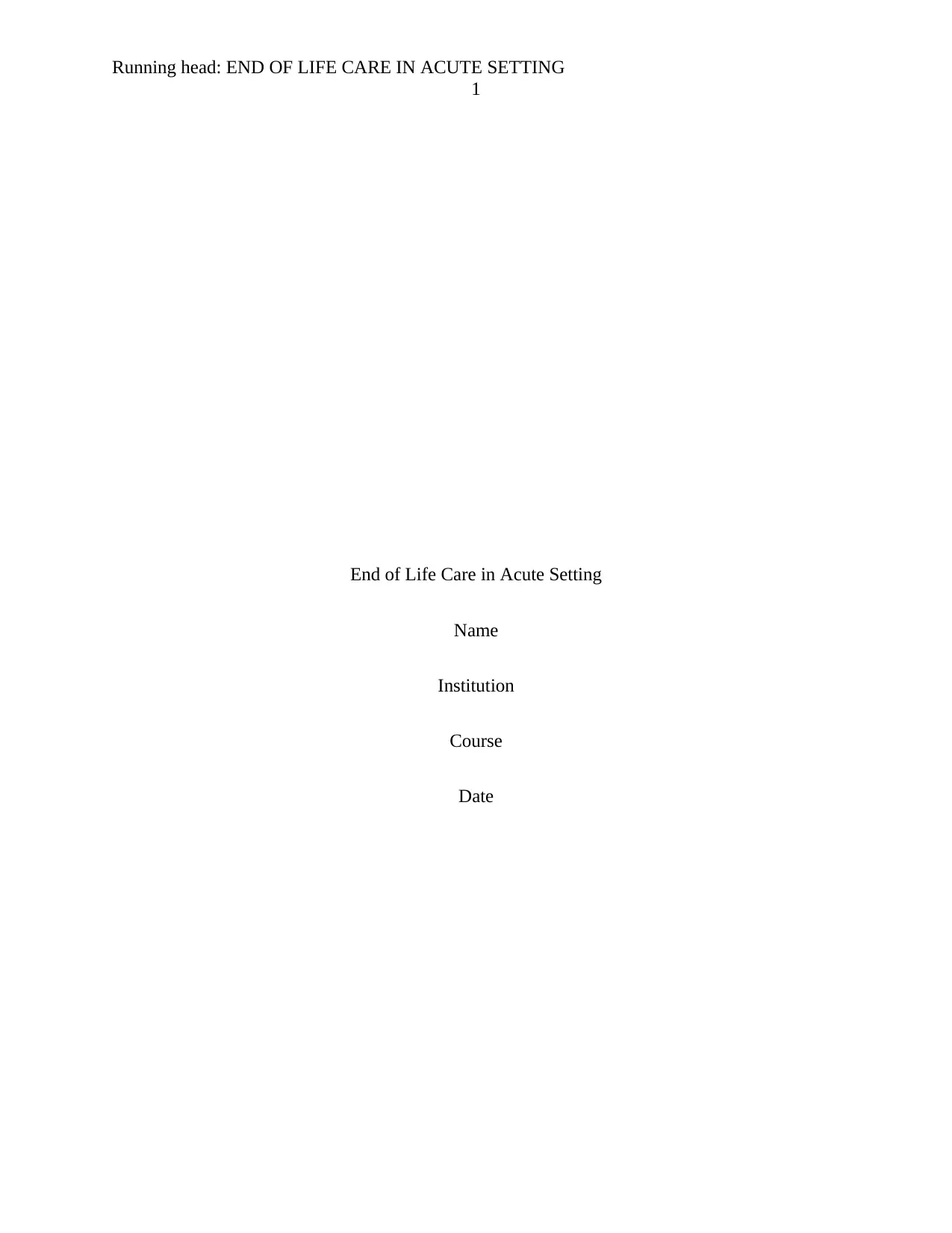
Running head: END OF LIFE CARE IN ACUTE SETTING
1
End of Life Care in Acute Setting
Name
Institution
Course
Date
1
End of Life Care in Acute Setting
Name
Institution
Course
Date
Paraphrase This Document
Need a fresh take? Get an instant paraphrase of this document with our AI Paraphraser
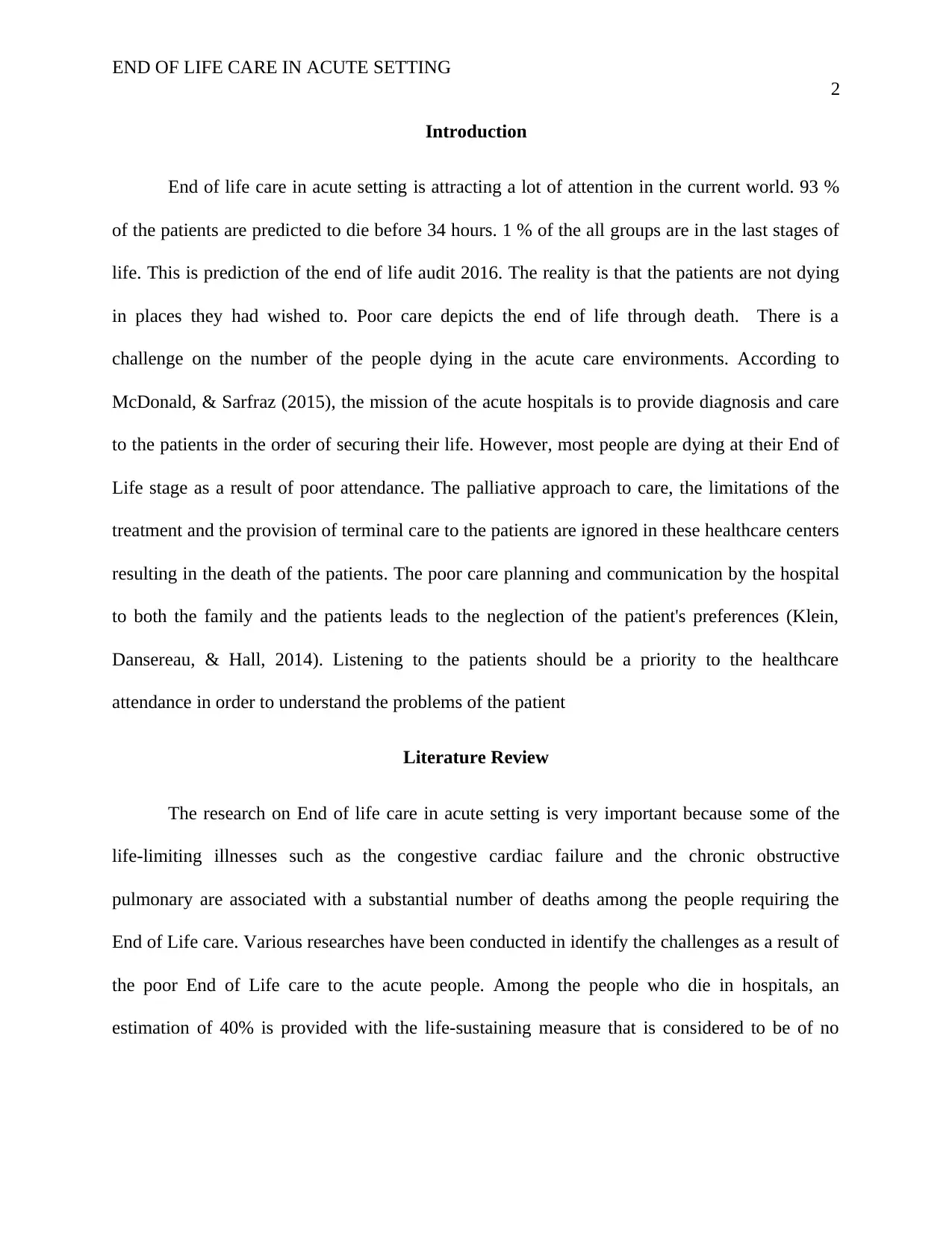
END OF LIFE CARE IN ACUTE SETTING
2
Introduction
End of life care in acute setting is attracting a lot of attention in the current world. 93 %
of the patients are predicted to die before 34 hours. 1 % of the all groups are in the last stages of
life. This is prediction of the end of life audit 2016. The reality is that the patients are not dying
in places they had wished to. Poor care depicts the end of life through death. There is a
challenge on the number of the people dying in the acute care environments. According to
McDonald, & Sarfraz (2015), the mission of the acute hospitals is to provide diagnosis and care
to the patients in the order of securing their life. However, most people are dying at their End of
Life stage as a result of poor attendance. The palliative approach to care, the limitations of the
treatment and the provision of terminal care to the patients are ignored in these healthcare centers
resulting in the death of the patients. The poor care planning and communication by the hospital
to both the family and the patients leads to the neglection of the patient's preferences (Klein,
Dansereau, & Hall, 2014). Listening to the patients should be a priority to the healthcare
attendance in order to understand the problems of the patient
Literature Review
The research on End of life care in acute setting is very important because some of the
life-limiting illnesses such as the congestive cardiac failure and the chronic obstructive
pulmonary are associated with a substantial number of deaths among the people requiring the
End of Life care. Various researches have been conducted in identify the challenges as a result of
the poor End of Life care to the acute people. Among the people who die in hospitals, an
estimation of 40% is provided with the life-sustaining measure that is considered to be of no
2
Introduction
End of life care in acute setting is attracting a lot of attention in the current world. 93 %
of the patients are predicted to die before 34 hours. 1 % of the all groups are in the last stages of
life. This is prediction of the end of life audit 2016. The reality is that the patients are not dying
in places they had wished to. Poor care depicts the end of life through death. There is a
challenge on the number of the people dying in the acute care environments. According to
McDonald, & Sarfraz (2015), the mission of the acute hospitals is to provide diagnosis and care
to the patients in the order of securing their life. However, most people are dying at their End of
Life stage as a result of poor attendance. The palliative approach to care, the limitations of the
treatment and the provision of terminal care to the patients are ignored in these healthcare centers
resulting in the death of the patients. The poor care planning and communication by the hospital
to both the family and the patients leads to the neglection of the patient's preferences (Klein,
Dansereau, & Hall, 2014). Listening to the patients should be a priority to the healthcare
attendance in order to understand the problems of the patient
Literature Review
The research on End of life care in acute setting is very important because some of the
life-limiting illnesses such as the congestive cardiac failure and the chronic obstructive
pulmonary are associated with a substantial number of deaths among the people requiring the
End of Life care. Various researches have been conducted in identify the challenges as a result of
the poor End of Life care to the acute people. Among the people who die in hospitals, an
estimation of 40% is provided with the life-sustaining measure that is considered to be of no
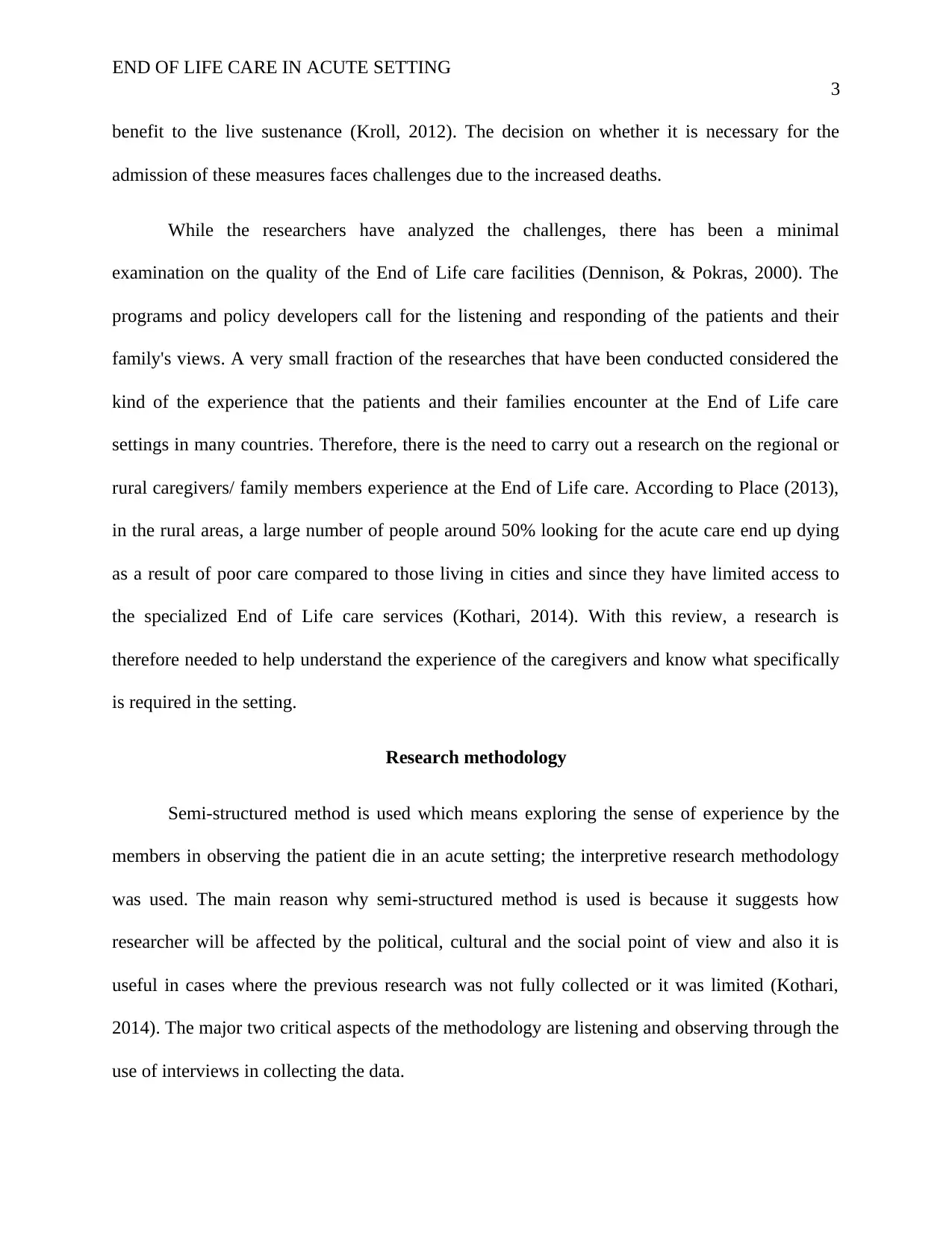
END OF LIFE CARE IN ACUTE SETTING
3
benefit to the live sustenance (Kroll, 2012). The decision on whether it is necessary for the
admission of these measures faces challenges due to the increased deaths.
While the researchers have analyzed the challenges, there has been a minimal
examination on the quality of the End of Life care facilities (Dennison, & Pokras, 2000). The
programs and policy developers call for the listening and responding of the patients and their
family's views. A very small fraction of the researches that have been conducted considered the
kind of the experience that the patients and their families encounter at the End of Life care
settings in many countries. Therefore, there is the need to carry out a research on the regional or
rural caregivers/ family members experience at the End of Life care. According to Place (2013),
in the rural areas, a large number of people around 50% looking for the acute care end up dying
as a result of poor care compared to those living in cities and since they have limited access to
the specialized End of Life care services (Kothari, 2014). With this review, a research is
therefore needed to help understand the experience of the caregivers and know what specifically
is required in the setting.
Research methodology
Semi-structured method is used which means exploring the sense of experience by the
members in observing the patient die in an acute setting; the interpretive research methodology
was used. The main reason why semi-structured method is used is because it suggests how
researcher will be affected by the political, cultural and the social point of view and also it is
useful in cases where the previous research was not fully collected or it was limited (Kothari,
2014). The major two critical aspects of the methodology are listening and observing through the
use of interviews in collecting the data.
3
benefit to the live sustenance (Kroll, 2012). The decision on whether it is necessary for the
admission of these measures faces challenges due to the increased deaths.
While the researchers have analyzed the challenges, there has been a minimal
examination on the quality of the End of Life care facilities (Dennison, & Pokras, 2000). The
programs and policy developers call for the listening and responding of the patients and their
family's views. A very small fraction of the researches that have been conducted considered the
kind of the experience that the patients and their families encounter at the End of Life care
settings in many countries. Therefore, there is the need to carry out a research on the regional or
rural caregivers/ family members experience at the End of Life care. According to Place (2013),
in the rural areas, a large number of people around 50% looking for the acute care end up dying
as a result of poor care compared to those living in cities and since they have limited access to
the specialized End of Life care services (Kothari, 2014). With this review, a research is
therefore needed to help understand the experience of the caregivers and know what specifically
is required in the setting.
Research methodology
Semi-structured method is used which means exploring the sense of experience by the
members in observing the patient die in an acute setting; the interpretive research methodology
was used. The main reason why semi-structured method is used is because it suggests how
researcher will be affected by the political, cultural and the social point of view and also it is
useful in cases where the previous research was not fully collected or it was limited (Kothari,
2014). The major two critical aspects of the methodology are listening and observing through the
use of interviews in collecting the data.
⊘ This is a preview!⊘
Do you want full access?
Subscribe today to unlock all pages.

Trusted by 1+ million students worldwide
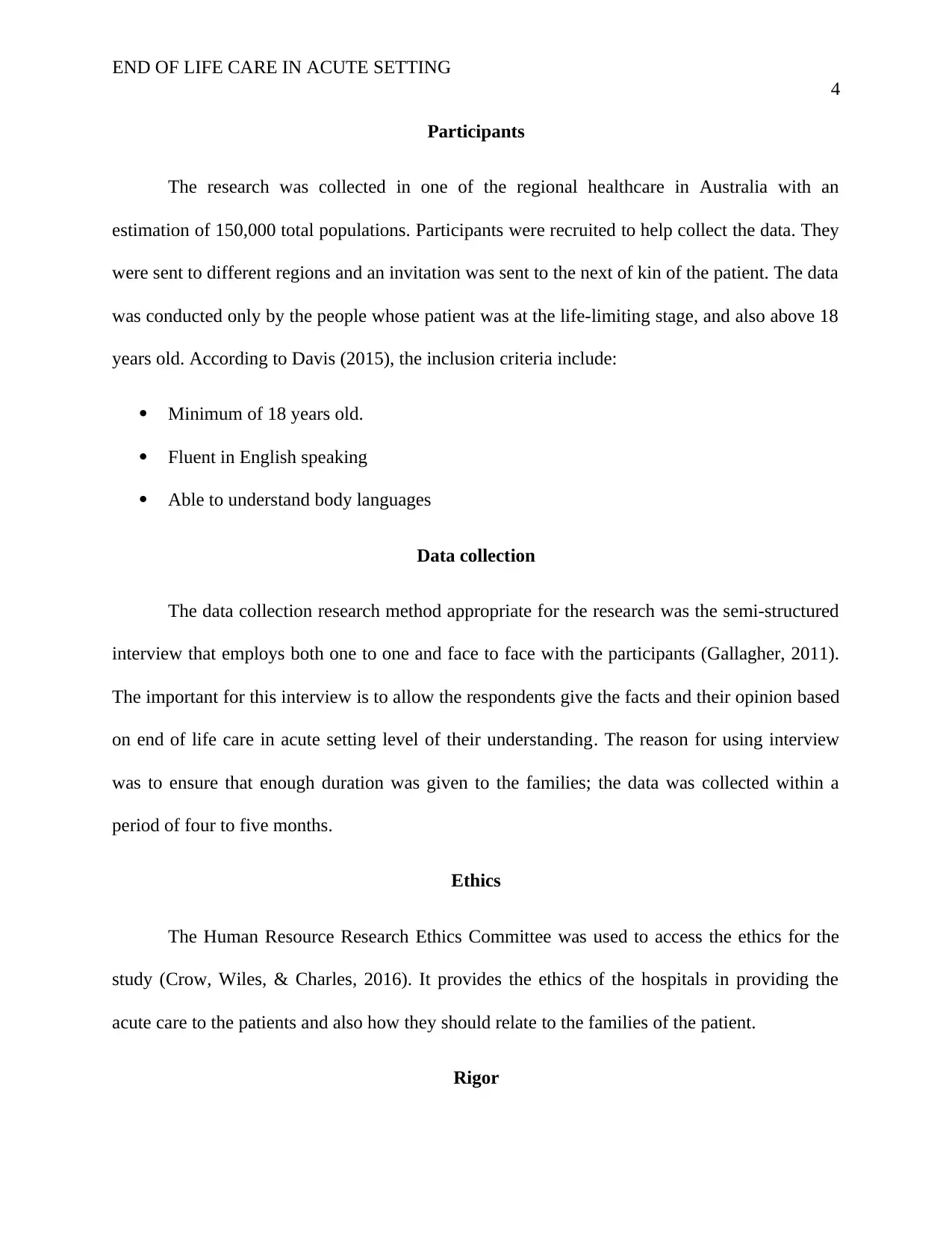
END OF LIFE CARE IN ACUTE SETTING
4
Participants
The research was collected in one of the regional healthcare in Australia with an
estimation of 150,000 total populations. Participants were recruited to help collect the data. They
were sent to different regions and an invitation was sent to the next of kin of the patient. The data
was conducted only by the people whose patient was at the life-limiting stage, and also above 18
years old. According to Davis (2015), the inclusion criteria include:
Minimum of 18 years old.
Fluent in English speaking
Able to understand body languages
Data collection
The data collection research method appropriate for the research was the semi-structured
interview that employs both one to one and face to face with the participants (Gallagher, 2011).
The important for this interview is to allow the respondents give the facts and their opinion based
on end of life care in acute setting level of their understanding. The reason for using interview
was to ensure that enough duration was given to the families; the data was collected within a
period of four to five months.
Ethics
The Human Resource Research Ethics Committee was used to access the ethics for the
study (Crow, Wiles, & Charles, 2016). It provides the ethics of the hospitals in providing the
acute care to the patients and also how they should relate to the families of the patient.
Rigor
4
Participants
The research was collected in one of the regional healthcare in Australia with an
estimation of 150,000 total populations. Participants were recruited to help collect the data. They
were sent to different regions and an invitation was sent to the next of kin of the patient. The data
was conducted only by the people whose patient was at the life-limiting stage, and also above 18
years old. According to Davis (2015), the inclusion criteria include:
Minimum of 18 years old.
Fluent in English speaking
Able to understand body languages
Data collection
The data collection research method appropriate for the research was the semi-structured
interview that employs both one to one and face to face with the participants (Gallagher, 2011).
The important for this interview is to allow the respondents give the facts and their opinion based
on end of life care in acute setting level of their understanding. The reason for using interview
was to ensure that enough duration was given to the families; the data was collected within a
period of four to five months.
Ethics
The Human Resource Research Ethics Committee was used to access the ethics for the
study (Crow, Wiles, & Charles, 2016). It provides the ethics of the hospitals in providing the
acute care to the patients and also how they should relate to the families of the patient.
Rigor
Paraphrase This Document
Need a fresh take? Get an instant paraphrase of this document with our AI Paraphraser
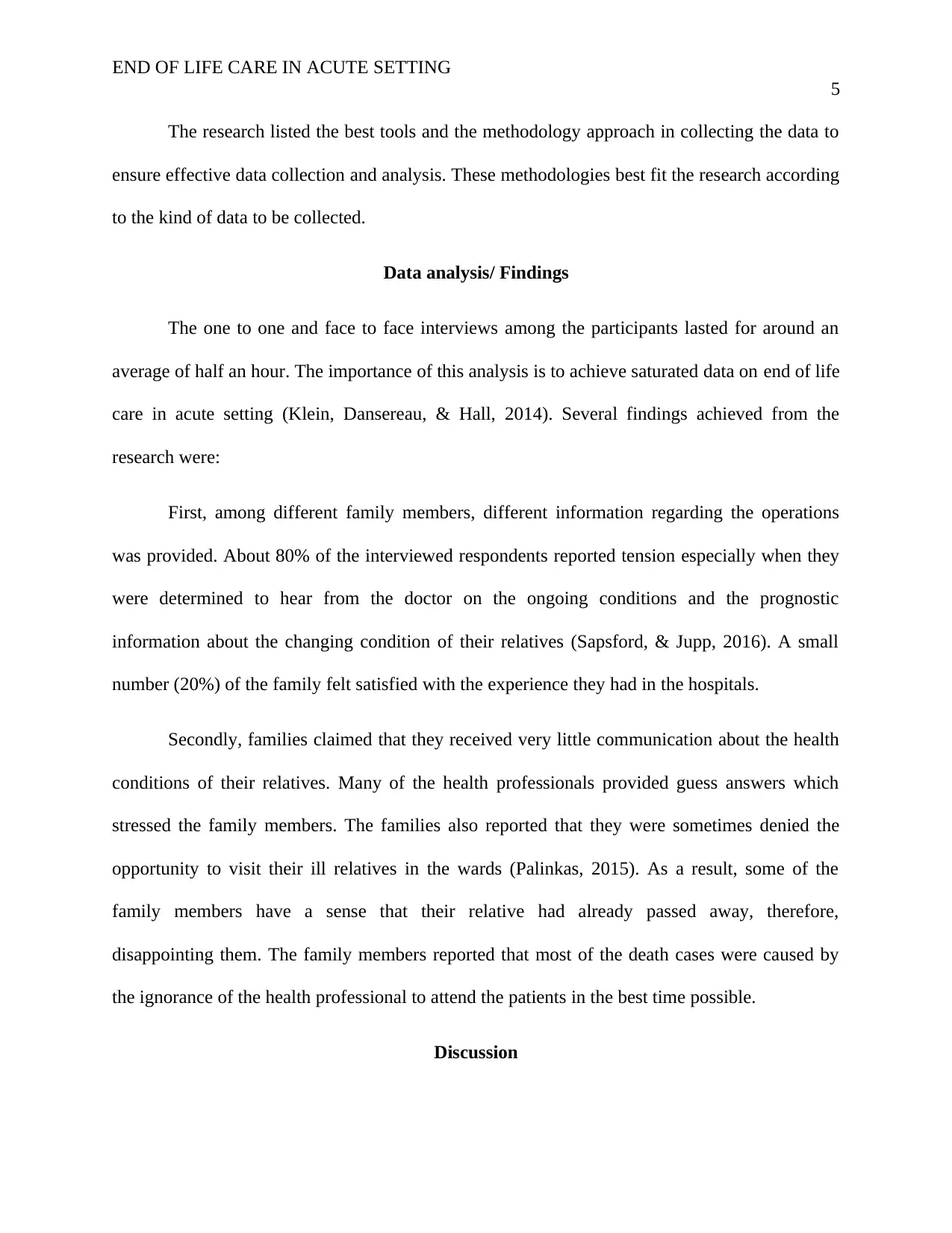
END OF LIFE CARE IN ACUTE SETTING
5
The research listed the best tools and the methodology approach in collecting the data to
ensure effective data collection and analysis. These methodologies best fit the research according
to the kind of data to be collected.
Data analysis/ Findings
The one to one and face to face interviews among the participants lasted for around an
average of half an hour. The importance of this analysis is to achieve saturated data on end of life
care in acute setting (Klein, Dansereau, & Hall, 2014). Several findings achieved from the
research were:
First, among different family members, different information regarding the operations
was provided. About 80% of the interviewed respondents reported tension especially when they
were determined to hear from the doctor on the ongoing conditions and the prognostic
information about the changing condition of their relatives (Sapsford, & Jupp, 2016). A small
number (20%) of the family felt satisfied with the experience they had in the hospitals.
Secondly, families claimed that they received very little communication about the health
conditions of their relatives. Many of the health professionals provided guess answers which
stressed the family members. The families also reported that they were sometimes denied the
opportunity to visit their ill relatives in the wards (Palinkas, 2015). As a result, some of the
family members have a sense that their relative had already passed away, therefore,
disappointing them. The family members reported that most of the death cases were caused by
the ignorance of the health professional to attend the patients in the best time possible.
Discussion
5
The research listed the best tools and the methodology approach in collecting the data to
ensure effective data collection and analysis. These methodologies best fit the research according
to the kind of data to be collected.
Data analysis/ Findings
The one to one and face to face interviews among the participants lasted for around an
average of half an hour. The importance of this analysis is to achieve saturated data on end of life
care in acute setting (Klein, Dansereau, & Hall, 2014). Several findings achieved from the
research were:
First, among different family members, different information regarding the operations
was provided. About 80% of the interviewed respondents reported tension especially when they
were determined to hear from the doctor on the ongoing conditions and the prognostic
information about the changing condition of their relatives (Sapsford, & Jupp, 2016). A small
number (20%) of the family felt satisfied with the experience they had in the hospitals.
Secondly, families claimed that they received very little communication about the health
conditions of their relatives. Many of the health professionals provided guess answers which
stressed the family members. The families also reported that they were sometimes denied the
opportunity to visit their ill relatives in the wards (Palinkas, 2015). As a result, some of the
family members have a sense that their relative had already passed away, therefore,
disappointing them. The family members reported that most of the death cases were caused by
the ignorance of the health professional to attend the patients in the best time possible.
Discussion
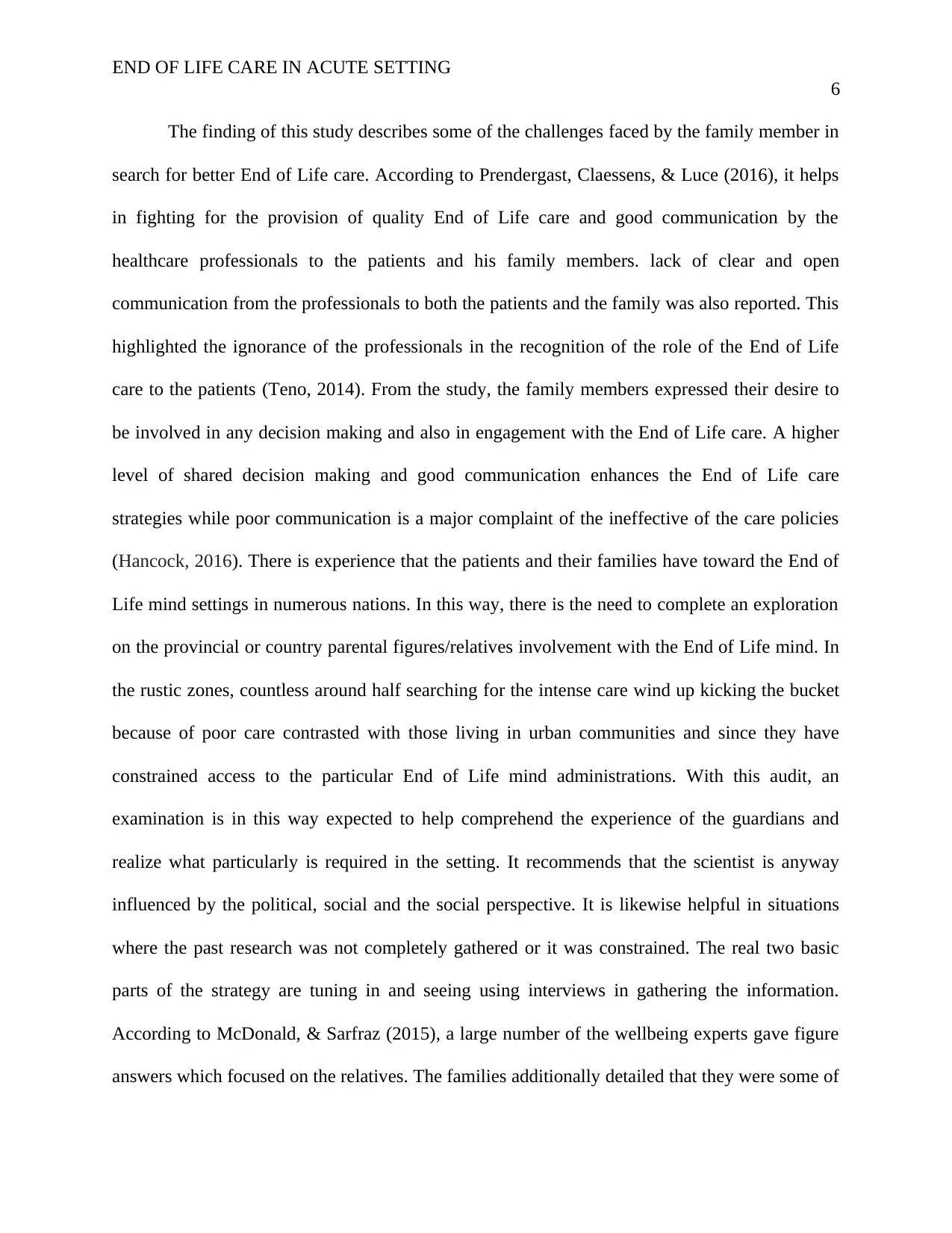
END OF LIFE CARE IN ACUTE SETTING
6
The finding of this study describes some of the challenges faced by the family member in
search for better End of Life care. According to Prendergast, Claessens, & Luce (2016), it helps
in fighting for the provision of quality End of Life care and good communication by the
healthcare professionals to the patients and his family members. lack of clear and open
communication from the professionals to both the patients and the family was also reported. This
highlighted the ignorance of the professionals in the recognition of the role of the End of Life
care to the patients (Teno, 2014). From the study, the family members expressed their desire to
be involved in any decision making and also in engagement with the End of Life care. A higher
level of shared decision making and good communication enhances the End of Life care
strategies while poor communication is a major complaint of the ineffective of the care policies
(Hancock, 2016). There is experience that the patients and their families have toward the End of
Life mind settings in numerous nations. In this way, there is the need to complete an exploration
on the provincial or country parental figures/relatives involvement with the End of Life mind. In
the rustic zones, countless around half searching for the intense care wind up kicking the bucket
because of poor care contrasted with those living in urban communities and since they have
constrained access to the particular End of Life mind administrations. With this audit, an
examination is in this way expected to help comprehend the experience of the guardians and
realize what particularly is required in the setting. It recommends that the scientist is anyway
influenced by the political, social and the social perspective. It is likewise helpful in situations
where the past research was not completely gathered or it was constrained. The real two basic
parts of the strategy are tuning in and seeing using interviews in gathering the information.
According to McDonald, & Sarfraz (2015), a large number of the wellbeing experts gave figure
answers which focused on the relatives. The families additionally detailed that they were some of
6
The finding of this study describes some of the challenges faced by the family member in
search for better End of Life care. According to Prendergast, Claessens, & Luce (2016), it helps
in fighting for the provision of quality End of Life care and good communication by the
healthcare professionals to the patients and his family members. lack of clear and open
communication from the professionals to both the patients and the family was also reported. This
highlighted the ignorance of the professionals in the recognition of the role of the End of Life
care to the patients (Teno, 2014). From the study, the family members expressed their desire to
be involved in any decision making and also in engagement with the End of Life care. A higher
level of shared decision making and good communication enhances the End of Life care
strategies while poor communication is a major complaint of the ineffective of the care policies
(Hancock, 2016). There is experience that the patients and their families have toward the End of
Life mind settings in numerous nations. In this way, there is the need to complete an exploration
on the provincial or country parental figures/relatives involvement with the End of Life mind. In
the rustic zones, countless around half searching for the intense care wind up kicking the bucket
because of poor care contrasted with those living in urban communities and since they have
constrained access to the particular End of Life mind administrations. With this audit, an
examination is in this way expected to help comprehend the experience of the guardians and
realize what particularly is required in the setting. It recommends that the scientist is anyway
influenced by the political, social and the social perspective. It is likewise helpful in situations
where the past research was not completely gathered or it was constrained. The real two basic
parts of the strategy are tuning in and seeing using interviews in gathering the information.
According to McDonald, & Sarfraz (2015), a large number of the wellbeing experts gave figure
answers which focused on the relatives. The families additionally detailed that they were some of
⊘ This is a preview!⊘
Do you want full access?
Subscribe today to unlock all pages.

Trusted by 1+ million students worldwide
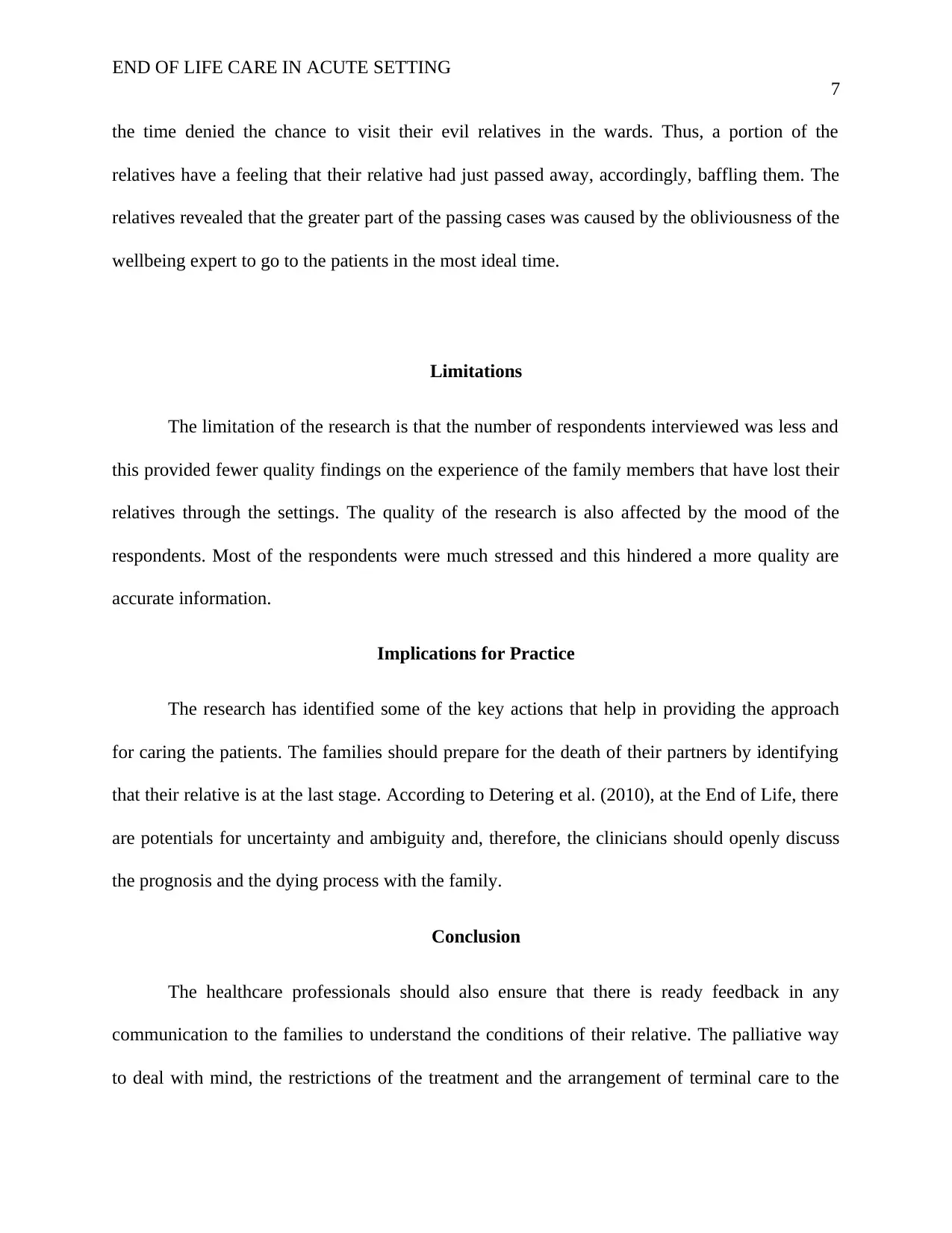
END OF LIFE CARE IN ACUTE SETTING
7
the time denied the chance to visit their evil relatives in the wards. Thus, a portion of the
relatives have a feeling that their relative had just passed away, accordingly, baffling them. The
relatives revealed that the greater part of the passing cases was caused by the obliviousness of the
wellbeing expert to go to the patients in the most ideal time.
Limitations
The limitation of the research is that the number of respondents interviewed was less and
this provided fewer quality findings on the experience of the family members that have lost their
relatives through the settings. The quality of the research is also affected by the mood of the
respondents. Most of the respondents were much stressed and this hindered a more quality are
accurate information.
Implications for Practice
The research has identified some of the key actions that help in providing the approach
for caring the patients. The families should prepare for the death of their partners by identifying
that their relative is at the last stage. According to Detering et al. (2010), at the End of Life, there
are potentials for uncertainty and ambiguity and, therefore, the clinicians should openly discuss
the prognosis and the dying process with the family.
Conclusion
The healthcare professionals should also ensure that there is ready feedback in any
communication to the families to understand the conditions of their relative. The palliative way
to deal with mind, the restrictions of the treatment and the arrangement of terminal care to the
7
the time denied the chance to visit their evil relatives in the wards. Thus, a portion of the
relatives have a feeling that their relative had just passed away, accordingly, baffling them. The
relatives revealed that the greater part of the passing cases was caused by the obliviousness of the
wellbeing expert to go to the patients in the most ideal time.
Limitations
The limitation of the research is that the number of respondents interviewed was less and
this provided fewer quality findings on the experience of the family members that have lost their
relatives through the settings. The quality of the research is also affected by the mood of the
respondents. Most of the respondents were much stressed and this hindered a more quality are
accurate information.
Implications for Practice
The research has identified some of the key actions that help in providing the approach
for caring the patients. The families should prepare for the death of their partners by identifying
that their relative is at the last stage. According to Detering et al. (2010), at the End of Life, there
are potentials for uncertainty and ambiguity and, therefore, the clinicians should openly discuss
the prognosis and the dying process with the family.
Conclusion
The healthcare professionals should also ensure that there is ready feedback in any
communication to the families to understand the conditions of their relative. The palliative way
to deal with mind, the restrictions of the treatment and the arrangement of terminal care to the
Paraphrase This Document
Need a fresh take? Get an instant paraphrase of this document with our AI Paraphraser
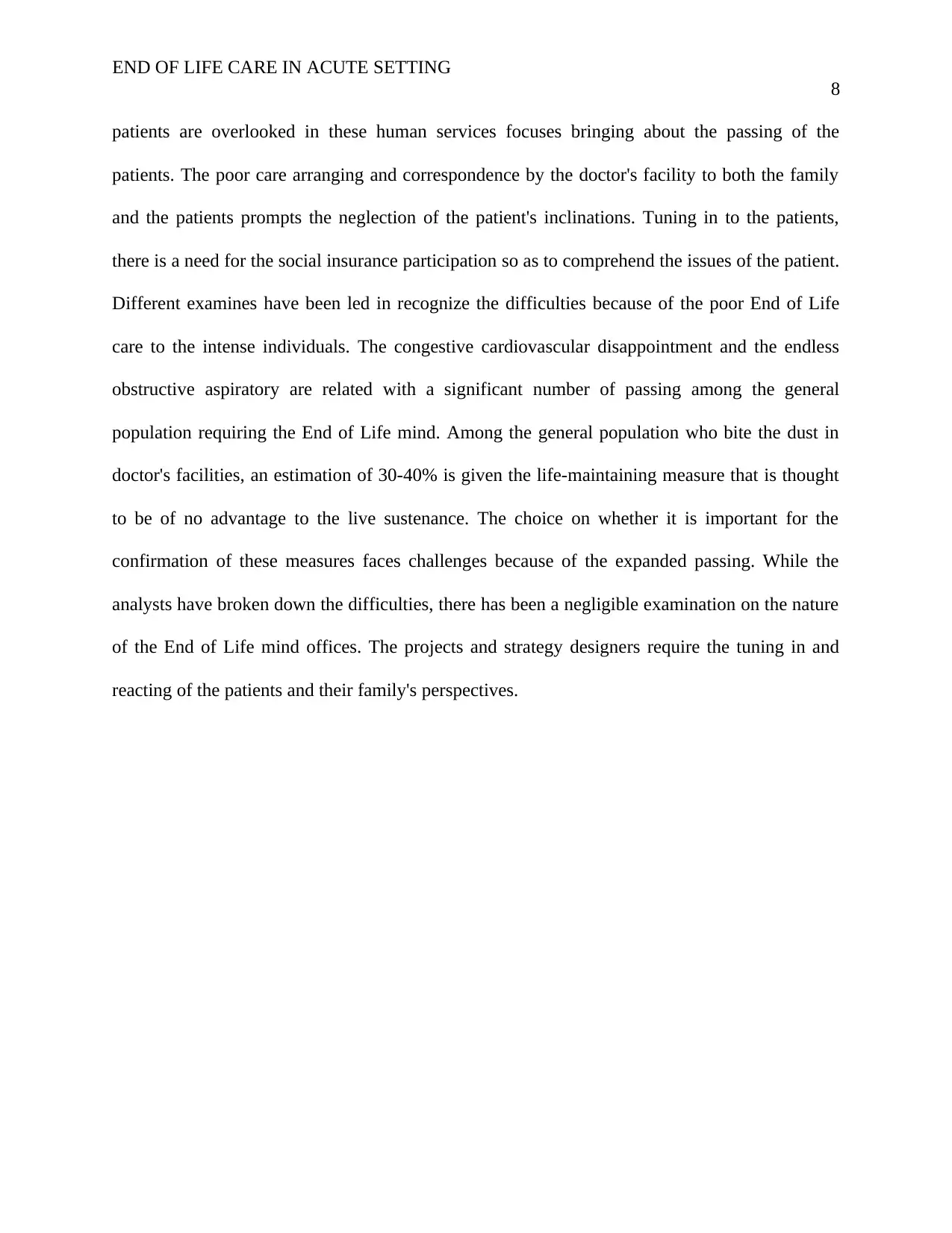
END OF LIFE CARE IN ACUTE SETTING
8
patients are overlooked in these human services focuses bringing about the passing of the
patients. The poor care arranging and correspondence by the doctor's facility to both the family
and the patients prompts the neglection of the patient's inclinations. Tuning in to the patients,
there is a need for the social insurance participation so as to comprehend the issues of the patient.
Different examines have been led in recognize the difficulties because of the poor End of Life
care to the intense individuals. The congestive cardiovascular disappointment and the endless
obstructive aspiratory are related with a significant number of passing among the general
population requiring the End of Life mind. Among the general population who bite the dust in
doctor's facilities, an estimation of 30-40% is given the life-maintaining measure that is thought
to be of no advantage to the live sustenance. The choice on whether it is important for the
confirmation of these measures faces challenges because of the expanded passing. While the
analysts have broken down the difficulties, there has been a negligible examination on the nature
of the End of Life mind offices. The projects and strategy designers require the tuning in and
reacting of the patients and their family's perspectives.
8
patients are overlooked in these human services focuses bringing about the passing of the
patients. The poor care arranging and correspondence by the doctor's facility to both the family
and the patients prompts the neglection of the patient's inclinations. Tuning in to the patients,
there is a need for the social insurance participation so as to comprehend the issues of the patient.
Different examines have been led in recognize the difficulties because of the poor End of Life
care to the intense individuals. The congestive cardiovascular disappointment and the endless
obstructive aspiratory are related with a significant number of passing among the general
population requiring the End of Life mind. Among the general population who bite the dust in
doctor's facilities, an estimation of 30-40% is given the life-maintaining measure that is thought
to be of no advantage to the live sustenance. The choice on whether it is important for the
confirmation of these measures faces challenges because of the expanded passing. While the
analysts have broken down the difficulties, there has been a negligible examination on the nature
of the End of Life mind offices. The projects and strategy designers require the tuning in and
reacting of the patients and their family's perspectives.
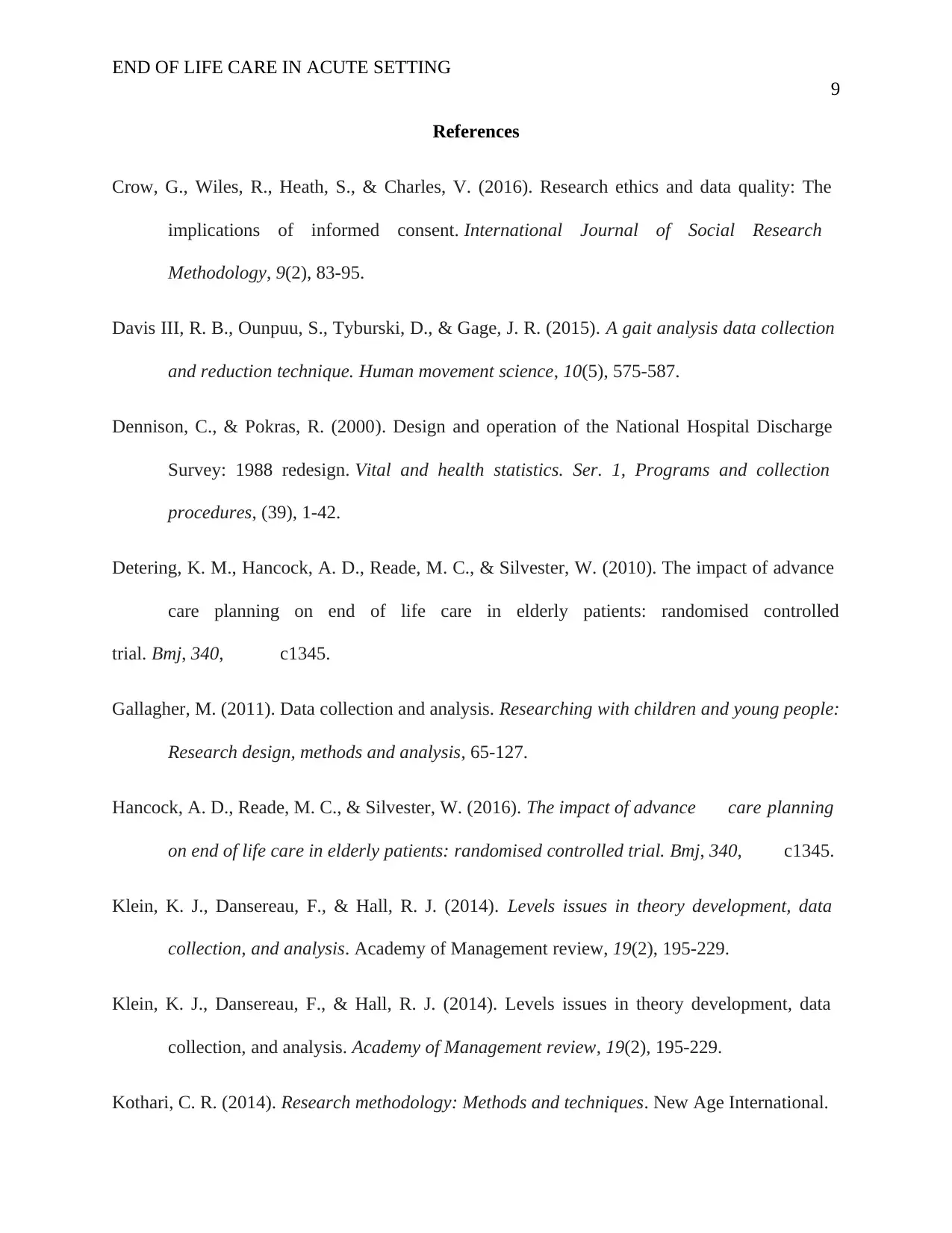
END OF LIFE CARE IN ACUTE SETTING
9
References
Crow, G., Wiles, R., Heath, S., & Charles, V. (2016). Research ethics and data quality: The
implications of informed consent. International Journal of Social Research
Methodology, 9(2), 83-95.
Davis III, R. B., Ounpuu, S., Tyburski, D., & Gage, J. R. (2015). A gait analysis data collection
and reduction technique. Human movement science, 10(5), 575-587.
Dennison, C., & Pokras, R. (2000). Design and operation of the National Hospital Discharge
Survey: 1988 redesign. Vital and health statistics. Ser. 1, Programs and collection
procedures, (39), 1-42.
Detering, K. M., Hancock, A. D., Reade, M. C., & Silvester, W. (2010). The impact of advance
care planning on end of life care in elderly patients: randomised controlled
trial. Bmj, 340, c1345.
Gallagher, M. (2011). Data collection and analysis. Researching with children and young people:
Research design, methods and analysis, 65-127.
Hancock, A. D., Reade, M. C., & Silvester, W. (2016). The impact of advance care planning
on end of life care in elderly patients: randomised controlled trial. Bmj, 340, c1345.
Klein, K. J., Dansereau, F., & Hall, R. J. (2014). Levels issues in theory development, data
collection, and analysis. Academy of Management review, 19(2), 195-229.
Klein, K. J., Dansereau, F., & Hall, R. J. (2014). Levels issues in theory development, data
collection, and analysis. Academy of Management review, 19(2), 195-229.
Kothari, C. R. (2014). Research methodology: Methods and techniques. New Age International.
9
References
Crow, G., Wiles, R., Heath, S., & Charles, V. (2016). Research ethics and data quality: The
implications of informed consent. International Journal of Social Research
Methodology, 9(2), 83-95.
Davis III, R. B., Ounpuu, S., Tyburski, D., & Gage, J. R. (2015). A gait analysis data collection
and reduction technique. Human movement science, 10(5), 575-587.
Dennison, C., & Pokras, R. (2000). Design and operation of the National Hospital Discharge
Survey: 1988 redesign. Vital and health statistics. Ser. 1, Programs and collection
procedures, (39), 1-42.
Detering, K. M., Hancock, A. D., Reade, M. C., & Silvester, W. (2010). The impact of advance
care planning on end of life care in elderly patients: randomised controlled
trial. Bmj, 340, c1345.
Gallagher, M. (2011). Data collection and analysis. Researching with children and young people:
Research design, methods and analysis, 65-127.
Hancock, A. D., Reade, M. C., & Silvester, W. (2016). The impact of advance care planning
on end of life care in elderly patients: randomised controlled trial. Bmj, 340, c1345.
Klein, K. J., Dansereau, F., & Hall, R. J. (2014). Levels issues in theory development, data
collection, and analysis. Academy of Management review, 19(2), 195-229.
Klein, K. J., Dansereau, F., & Hall, R. J. (2014). Levels issues in theory development, data
collection, and analysis. Academy of Management review, 19(2), 195-229.
Kothari, C. R. (2014). Research methodology: Methods and techniques. New Age International.
⊘ This is a preview!⊘
Do you want full access?
Subscribe today to unlock all pages.

Trusted by 1+ million students worldwide
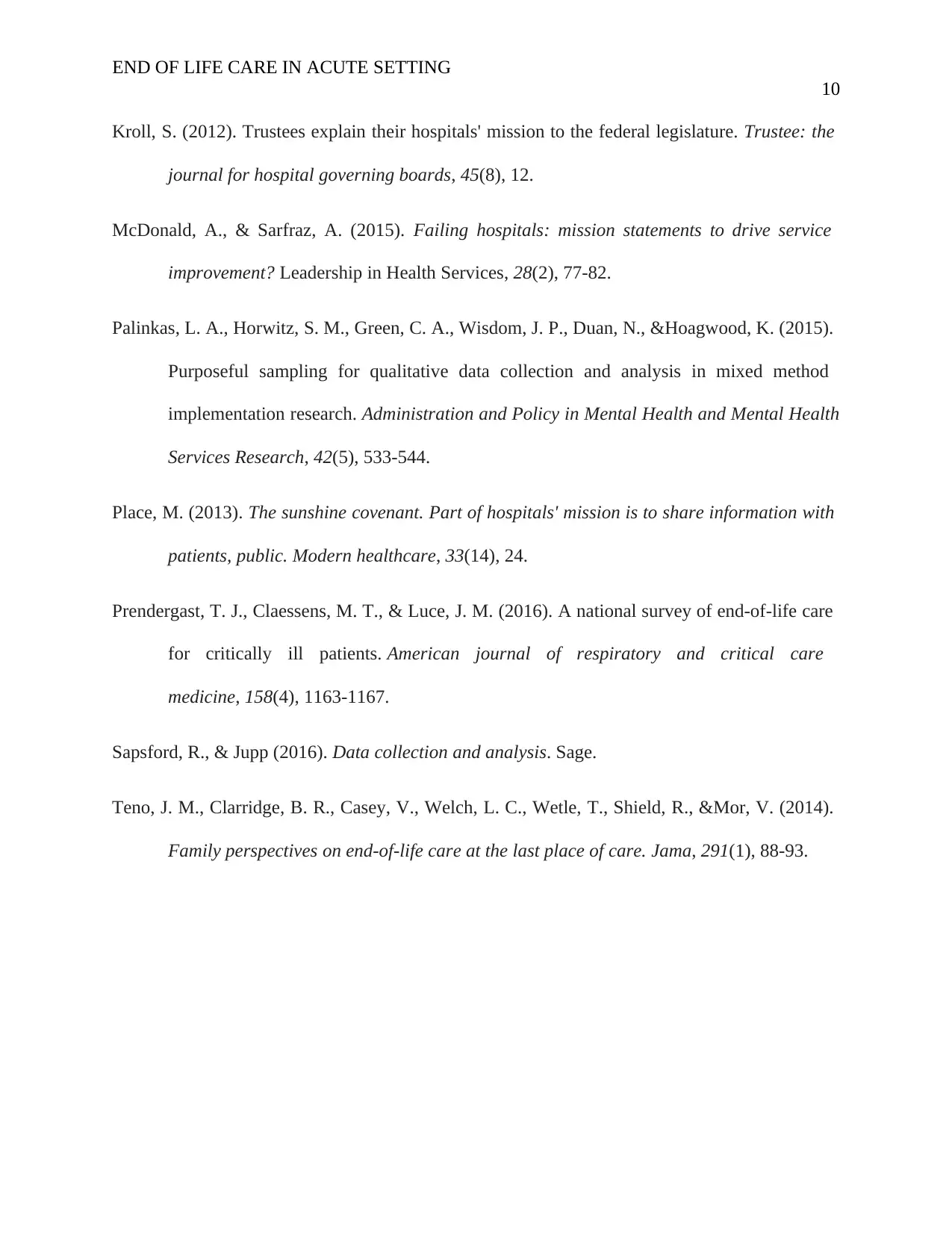
END OF LIFE CARE IN ACUTE SETTING
10
Kroll, S. (2012). Trustees explain their hospitals' mission to the federal legislature. Trustee: the
journal for hospital governing boards, 45(8), 12.
McDonald, A., & Sarfraz, A. (2015). Failing hospitals: mission statements to drive service
improvement? Leadership in Health Services, 28(2), 77-82.
Palinkas, L. A., Horwitz, S. M., Green, C. A., Wisdom, J. P., Duan, N., &Hoagwood, K. (2015).
Purposeful sampling for qualitative data collection and analysis in mixed method
implementation research. Administration and Policy in Mental Health and Mental Health
Services Research, 42(5), 533-544.
Place, M. (2013). The sunshine covenant. Part of hospitals' mission is to share information with
patients, public. Modern healthcare, 33(14), 24.
Prendergast, T. J., Claessens, M. T., & Luce, J. M. (2016). A national survey of end-of-life care
for critically ill patients. American journal of respiratory and critical care
medicine, 158(4), 1163-1167.
Sapsford, R., & Jupp (2016). Data collection and analysis. Sage.
Teno, J. M., Clarridge, B. R., Casey, V., Welch, L. C., Wetle, T., Shield, R., &Mor, V. (2014).
Family perspectives on end-of-life care at the last place of care. Jama, 291(1), 88-93.
10
Kroll, S. (2012). Trustees explain their hospitals' mission to the federal legislature. Trustee: the
journal for hospital governing boards, 45(8), 12.
McDonald, A., & Sarfraz, A. (2015). Failing hospitals: mission statements to drive service
improvement? Leadership in Health Services, 28(2), 77-82.
Palinkas, L. A., Horwitz, S. M., Green, C. A., Wisdom, J. P., Duan, N., &Hoagwood, K. (2015).
Purposeful sampling for qualitative data collection and analysis in mixed method
implementation research. Administration and Policy in Mental Health and Mental Health
Services Research, 42(5), 533-544.
Place, M. (2013). The sunshine covenant. Part of hospitals' mission is to share information with
patients, public. Modern healthcare, 33(14), 24.
Prendergast, T. J., Claessens, M. T., & Luce, J. M. (2016). A national survey of end-of-life care
for critically ill patients. American journal of respiratory and critical care
medicine, 158(4), 1163-1167.
Sapsford, R., & Jupp (2016). Data collection and analysis. Sage.
Teno, J. M., Clarridge, B. R., Casey, V., Welch, L. C., Wetle, T., Shield, R., &Mor, V. (2014).
Family perspectives on end-of-life care at the last place of care. Jama, 291(1), 88-93.
1 out of 10
Related Documents
Your All-in-One AI-Powered Toolkit for Academic Success.
+13062052269
info@desklib.com
Available 24*7 on WhatsApp / Email
![[object Object]](/_next/static/media/star-bottom.7253800d.svg)
Unlock your academic potential
Copyright © 2020–2025 A2Z Services. All Rights Reserved. Developed and managed by ZUCOL.





